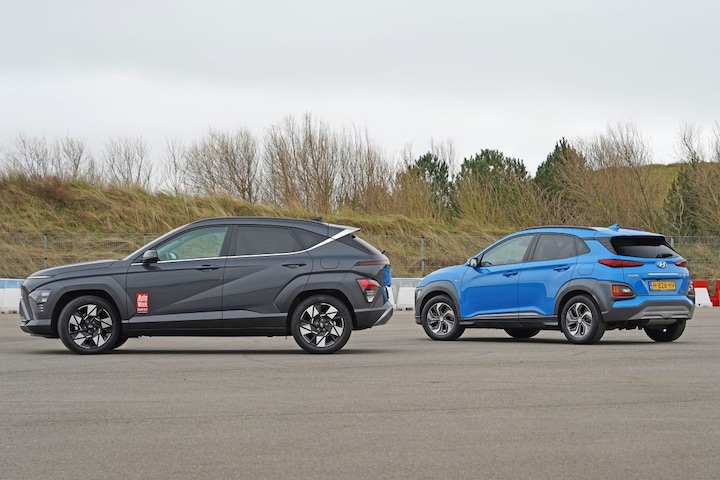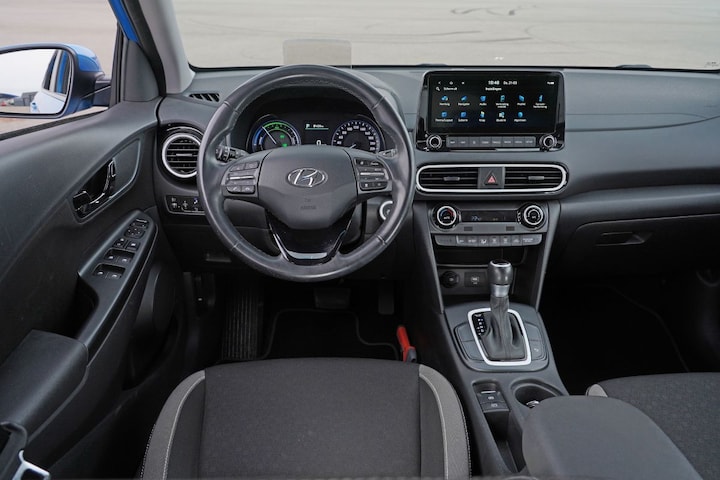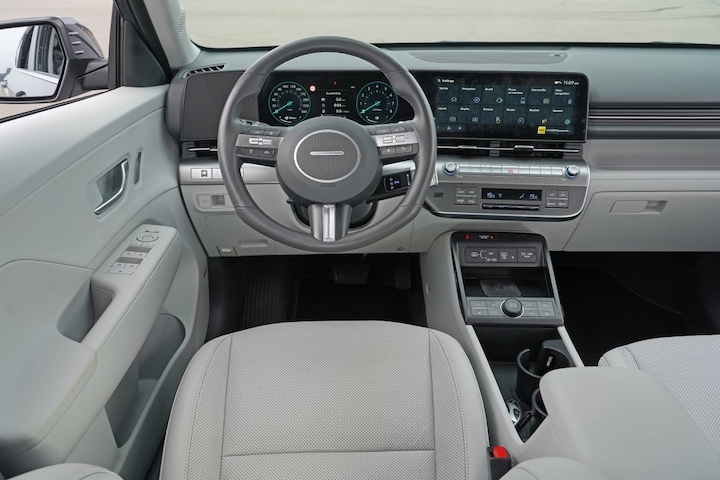Drivetrain remained the same

Hyundai changed course radically for the second model series of the Kona. The popular crossover lost its innocence and grew from an adolescent to a serious adult. Time for a comparison: the Kona HEV from the AutoWeek endurance test fleet meets its predecessor.
There is a simple explanation for the resounding success of the Hyundai Kona. It comes at the right time, it’s a compact crossover and it has the proverbial South Korean build quality and reliability. 1.7 million units will be sold worldwide between 2017 and 2023. Europe accounts for a third of this and one in three of all Konas delivered in the Schengen area is electric.

The second model series has been on the road since the end of 2023: an even more striking appearance than the original Kona and, at first glance, a lot larger. Although cars have been significantly digitized in 2017, Hyundai has made a significant leap with the latest Kona, so that it is fully in line with what governments and consumers demand from a modern car. That starts with the design. The ‘old’ Kona is quite busy and playful in shape, like a not yet fully grown teenager. Rounded and elegant sheet metal parts determine the image together with the prominent fender and sill frames made of black plastic, which should radiate off-road skills. Hyundai, following Citroën, is early with narrow, elongated daytime running lights, in addition to separate units for high beam and fog lights. The ‘original Kona’ rides on a wheelbase of only 2.6 meters and measures a total of only 4 by 1.8 meters. The footprint of his successor is clearly larger. For example, the 18-inch wheels (standard 16 inches) are now 2.66 meters apart and the total length is over 4.5 meters due to larger overhangs at the front and rear.

This shape, drawn by a Russian and three Koreans, is strict and contemporary. The playfulness of the first model has made way for contemporary aggression, a mixture of sharp folds, triangles and curves. Four details stand out: the double fold in the flanks that originates from the rear fender and ends in the front door, the white LED strip at the front, the red LED strip across the entire width of the rear and the slightly exaggeratedly thick fender frames made of black plastic. The seriously designed 18-inch wheels on the endurance test car fit into that image. Smaller would be out of place. The roof visually slopes sharply, but appearances are deceiving: it is only the chrome frame that swings downwards.

Interior of the first Hyundai Kona.
You can see how quickly things are going from interiors Kona 1 and 2
What applies to the exteriors also applies to the interiors of both Konas. Particularly from the interior of the first generation, we can see how quickly developments follow each other. With its hard and hardly scratch-resistant plastics, it is a true exponent of its time. Organic curves determine the image and the perfect ergonomics, seating comfort and operation leave nothing to the imagination. Simply pressing or turning a button is sufficient to activate a function. The touchscreen is simple in design, so that old and young can use it. Our test car with the DCT automatic transmission still has the classic lever in the center console. It is also the epitome of clarity. The electric handbrake control, the USB connection to charge your smartphone with a real cable, the start button hidden behind the steering wheel and the available driving aids were already the norm in 2017.

Big screen in new Kona
How different in design is the interior of the new Kona. With its light gray color scheme, the atmosphere is literally night and day different. There is a lot to be said about the choice of such a light interior. Don’t accuse it of being ‘difficult to keep clean’, because a black interior will get dirty for a while. The design is completely contemporary: sleek, strict, rectangular and truly beautifully finished. It seems strongly inspired by the premium stereo towers from the 1970s and 1980s. Of course, the instrumentation is completely digital and the display continues uninterruptedly into the dashboard. Yet the clocks are round and display the usual information, supplemented with (un)desired extra information. The battery buttons for climate control and the regular rotary knobs for channel selection and volume form a kind of oasis under the touch controls of the large display. Of course, there are cameras all around, with the image clearer than ever before. Some study is needed to realize the many possibilities, but here too, young and old can easily find their way. Voice recognition simplifies operation. You charge your smartphone ‘on the induction plate’. The old-fashioned poker has disappeared; You can now operate the DCT automatic transmission from the steering wheel with a smooth turning movement.
The rear passengers find the six centimeters longer wheelbase pleasant. They clearly have more legroom than in the previous Kona. And thanks to the larger overhang, the luggage space increased considerably. The new Kona offers no less than ten centimeters more space up to the rear seat.

The space in the back of the first Hyundai Kona
Previous Kona still drives fine
To be clear: the first Kona is still completely up to date. The driving characteristics are pleasant. The high carriage in combination with the raised seat does not cause a tendency to lean over. It just sits tight and is pleasantly, albeit quite firmly, sprung. Actually even slightly more balanced than its successor. The latter is noticeably more affected by thresholds and on manhole covers you notice that the damping has difficulty processing them. The old Kona, on the other hand, produces more noise. Chassis noises are audible too clearly, especially from the luggage compartment. The new one has better sound insulation. The light steering feels a bit dead in both cars, but the Kona is in good company: heavy hydraulic installations are taboo these days.

Lots of electronic interference in the new Kona
The electronic interference in the first Kona is limited to lane correction and blind spot assistance. A head-up display provides extra convenience. Switching to the new Kona, equipped with all the driving assistance systems imposed by Brussels, NTSHA and NCAP, feels like a huge transition. A camera keeps a close eye on you, determines whether you need a cup of coffee and always demands your attention and your hands on the steering wheel. If you avert your eyes from the traffic or drive 1 km/h faster than the speed limit, there will be some wavering. ‘Big brother’ keeps you on your toes with an acoustic signal. In the long run this is extremely irritating, but fortunately it can be switched off… until you start the car again. On the right side of the steering column we find two levers: the upper one for the windshield wiper control, the lower one in the shape of a Mars bar that serves as a selector lever for the automatic transmission. It takes some getting used to, but you will quickly master the movement.
Powertrain unchanged: 1.6 GDI with system power of 141 hp
Despite all the euphoria about the modern design, the new Kona Hybrid drives with the same powertrain as its direct predecessor. Apparently Hyundai thinks it is modern enough. It consists of the familiar combination of the 105 hp 1.6 GDI engine with electrical assistance, good for 141 hp system power. Although the combination of the two works less smoothly than with competitor Toyota, it is quite lively thanks to the six-speed DCT dual-clutch automatic transmission. If you are considering switching to the new Kona, you will notice that little to no progress has been made in this discipline. We should have expected a seven- or eight-speed DCT. The beautiful design actually deserves better. The AutoWeek editors drive an average of 1 in 17.3 with the endurance test Kona HEV, which also includes trips abroad. Reviewers achieved an average of 1 out of 19 with the previous HEV. In the logbook we see entries of 1 in 20, but you have to make an extra effort for that. All in all, these are good figures for a car weighing 1,400 kilos.
– Thanks for information from Autoweek.nl